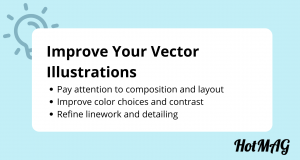Vector illustrations have become incredibly popular in recent years, and for good reason. They’re versatile, flexible, and can be used in a range of different contexts. However, not all vector illustrations are created equal. Some are good, some are great, and some are just plain average. If you want your vector illustrations to stand out from the crowd, you need to learn how to make them better. In this article, we’ll explore some essential vector art tips and tools that you can use to take your vector illustrations from good to great.

Why improving vector illustrations is important
Improving your vector illustrations is important for several reasons. For one thing, it can help you to create more engaging and effective designs. By paying attention to composition, color, and detail, you can create illustrations that are eye-catching, memorable, and communicate your message effectively. Additionally, improving your vector illustration skills can also help you to stand out in a crowded marketplace. As more and more designers and artists turn to vector illustrations, having the ability to create high-quality designs can help you to differentiate yourself from the competition.
Brief overview of the factors to consider when improving vector illustrations
When it comes to improving your vector illustrations, there are several factors to consider. These include composition, color, linework, texture, simplicity vs. complexity, and more. By paying attention to each of these elements, you can create illustrations that are more engaging, more effective, and more memorable. In the next section, we’ll explore some essential techniques that you can use to improve your vector illustrations.
Essential Techniques for Improving Vector Illustrations
- Paying attention to composition and layout

Composition and layout are essential elements of any good illustration. By considering the placement of different elements within your design, you can create illustrations that are more visually interesting and engaging. When thinking about composition, consider the rule of thirds, balance, and hierarchy. By following these principles, you can create a design that is both visually appealing and effective at communicating your message.
- Improving color choices and contrast
Vector color correction is another essential element of any good illustration. By choosing the right colors and using them effectively, you can create illustrations that are more visually interesting and engaging. When choosing colors, consider contrast, saturation, and hue. By playing with these elements, you can create designs that are more dynamic and visually interesting.
- Refining linework and detailing
Linework and detailing are also important elements of any good illustration. By refining your linework and adding details where appropriate, you can create illustrations that are more visually interesting and engaging. When working with linework, consider the weight, stroke, and style. By tweaking these elements, you can create designs that are more visually appealing and effective.
- Adding texture and depth to your illustrations
Vector texture addition can also help in enhancing vector illustrations. By adding texture and depth to your designs, you can create illustrations that feel more tactile and immersive. When adding texture, consider the type of texture, the scale, and the direction. By playing with these elements, you can create designs that are more visually engaging and effective.

- Balancing simplicity and complexity
Finally, it’s important to find the right balance between simplicity and complexity in your vector illustrations. While adding detail and complexity can help to create more visually interesting and engaging designs, it’s important not to overcomplicate things. By finding the right balance between simplicity and complexity, you can create illustrations that are both visually appealing and effective at communicating your message.
Tools and Resources for Improving Vector Illustrations
When it comes to improving your vector illustrations, there are a range of different vector software and hardware that you can use. Some of the most popular software for vector illustration includes Adobe Illustrator, Affinity Designer, and CorelDRAW. Additionally, there are countless online tutorials, courses, and resources available to help you improve your skills.
If you want to take your vector illustrations from good to great, it’s important to pay attention to a range of different factors. By improving your composition, color choices, linework, texture, and simplicity vs. complexity, you can create illustrations that are more engaging, effective, and memorable. Additionally, by using the right software and resources, you can continue to improve your skills and stay ahead of the competition. With a little practice and dedication, anyone can learn how to make their vector illustrations better.